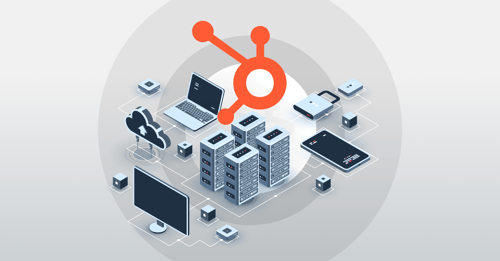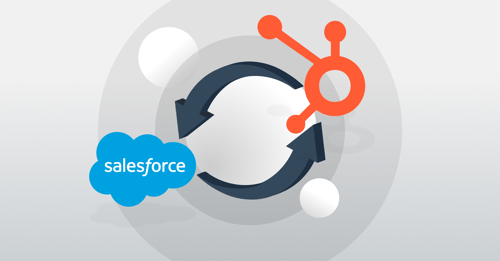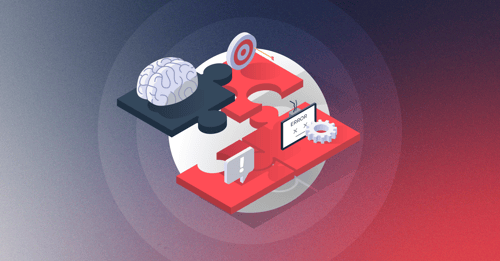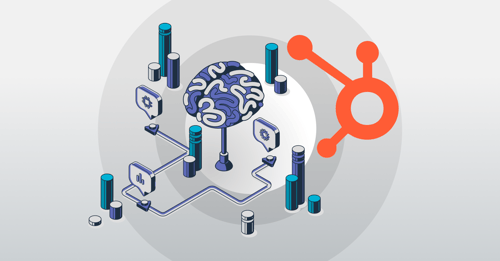In this article, you’ll learn more about the power of CRM and business process automation to drive your growth and optimise your operations.
In order to create a truly customer-centric business, you need to have a CRM system that spans your marketing, sales and service departments.
To make a CRM system as effective as possible, integrating your CRM and business process automation software is a must. All too often enterprises struggle to find operations software that connects with their CRM and helps them scale their business.
Typically, business process automation is driven by ERP software, like Sage or Microsoft Dynamics 365. However, if your CRM software is the foundation of your business, why wouldn’t you drive business process automation (BPA) from within your CRM too?
In this article, you will learn how you can use CRM-supported automation of business processes to grow your company.
Why you need CRM-driven business process automation
Technology can help companies complete menial, repetitive tasks, streamlining operations, boosting productivity and freeing employees to focus on higher-level work.
Technology-enabled automation - business process automation - is a cost-effective way to simplify complex business processes, speed up service delivery and ensure efficient resource management.
Key benefits of CRM-driven business process automation
Business process automation benefits multiple departments.
Set up properly, it can help your business scale and grow without losing momentum. While departments like marketing, sales, customer service and human resources thrive with BPA, the true strength of automation lies in cross-departmental collaboration.
Here’s what CRM-driven BPA can do for you:
- Get tailored automation: A CRM-driven BPA with programmable automation allows you to customise your automation around your customers, and your business. Ultimately, you get automation that is customisable, flexible and efficient.
- Execute all automation from one platform: As your company grows, your systems and processes can easily snowball. Add a disconnected tech stack to this mix and it’s a recipe for disaster. CRM-driven automation ensures you can execute automation from within one platform. For example, HubSpot’s CRM offers programmable automation, allowing you to code JavaScript actions and execute them within HubSpot.
- Boost cross-departmental collaboration: Automation from within your CRM also means better alignment between departments — using one tool means everything is connected — so information can be easily shared and managed.
- Keep your data secure: Using one system and no third-party services means your customer data isn’t at risk.
- Stay cost-effective: By embracing CRM-driven BPA, you don’t need to spend money on custom in-house builds and integrations — enjoying the ultimate in cost-efficiency without compromising on quality or data security.
At Huble, we believe in the power of business process automation to help organisations achieve their fullest potential - in fact, we’ve built our core service offerings around it.
But don’t take our word for it. Here’s Brian Sampsel - currently VP of AI and Automation at Covail - breaking down why you should embrace automation at TedX Columbus 2020:
How to evaluate your current business process automation strategy
Successful transformation depends on a well thought out business process automation strategy that identifies where and why it’s needed, and how success will be achieved.
Strategies are iterative, and fluid - so regularly revisit the one you have in play and evaluate it against your current BPA set up, and your latest business, or automation, goals.
Here are 3 essential steps to crafting, or updating, that perfect roadmap.
1. Know your business
Start by identifying all the places you could automate in your business across every department and role. If you’ve already got automation in place, review whether they’re optimised or if changing business processes have opened up new opportunities for automation. Then map out the what, where, why and how of every node in that network, what data is transferred, where it goes, why it’s needed and how it happens.
Every organisation is unique; knowing exactly where you can automate and how data is passed between points (and why) will inform which software or tools you can use for the best effect.
The following indicates that a process is a prime candidate for automation:
- The process requires consistency across the organisation
- The process is repeatable
- The process needs to be consistently error-free
Here are some examples of how business process automation makes a difference across multiple departments and functions:
Accounts Payable
Your accounts payable process can be streamlined from days to minutes. For example, it could be as simple as:
- A vendor completes an electronic form
- Automatic document routing
- Information stored in an easily searchable, secure electronic repository
Customer Service
If certain keywords show up in an email or chat, BPA software lets your customer service team know so they can quickly reach out with a relevant automated reply. You can also remove some tasks from their to-do lists entirely by, for instance, creating automated responses on chatbots for a list of FAQs.
HR Onboarding
BPA can reduce time and energy spent on screening candidates when recruiting and onboarding new hires. For example, prospective and new hires no longer need in-person contact to complete necessary paperwork. BPA software can transform your HR onboarding process into a 15-minute exercise including:
- Send forms and documents to candidate/recruit
- Automatic document routing to team and/or archives
- Onboarding completed, with all stakeholders informed
Social Media Marketing
Instead of manually uploading individual posts across multiple platforms, BPA software lets you curate content and schedule posts in bulk, in advance.
Customer Relationship Management
Imagine being able to keep track of every contact’s engagement with your company? BPA software like HubSpot’s Marketing Hub makes this possible, so you never risk sending a lead the same email twice!
Does your current automation hit the mark? If not, it may be time for an upgrade!
2. Does your BPA strategy follow best practice?
A best-in-class BPA blueprint relies on applying 7 notable principles from outset. Keep these in mind to cut down on errors and inefficiencies when automating your enterprise or updating an existing strategy.
-
Train your developers: Make sure every developer touching your BPA project understands the different tasks needing to be automated within the organisation. This makes sure they develop the right codes and scripts from outset.
-
Develop a task list: Record every task that needs to be automated (and which departments they touch). Then break them down into their constituent steps to ensure comprehensive automation.
-
Keep it simple: If automating a process or task overcomplicates it, pause for breath! Analyse existing processes and sets of tasks, then identify where you can reduce complexity to accommodate efficient, simple automation.
-
Be consistent: Abandoning a BPA rollout halfway through is worse than not automating at all. Create a business process automation strategy that supports automation that is used regularly, from start to finish.
-
Integrate properly: Your BPA shouldn’t break existing systems. Plan how and where you’ll integrate automations via APIs at different points in your processes.
-
Provide training: Help your employees transition into the new process. Supporting their proper use of automation software will boost adoption with minimal error.
-
Iterate: BPA is dynamic. Periodically revisit existing processes as your business grows and changes to ensure they remain en pointe.
3. Match the right software to your business needs
Once you’ve identified where you’ll be automated, and based or updated your business process automation strategy in line with the principles above, it’s time to identify which software you can use to support implementation. (We unpack how to choose the right enterprise automation software a little further down).
Challenges of business process automation
Like with any great organisational change, there are some challenges of business automation you need to be aware of, monitor and plan for to ensure a smooth transition. Forewarned is forearmed, and building in ways to deal with these potential risks in your strategy can save you time and money.
Have a plan to avoid or mitigate the following:
- Software that’s difficult to use: If possible, avoid BPA software that’s overcomplicated and unnecessarily difficult to use. Obfuscating UI and a taxing UX (see what we did there?) leads to low user adoption — rendering even the most promising software useless.
- Badly planned training: Training your team to use new software and follow new processes is fundamental to the success of your BPA project. But spearheading changes while training your team can stretch you too thin — consider outsourcing this to specialists.
- Resistance to change: Mistrust and lack of confidence in BPA software, fear of losing jobs, poor communication from leadership, unrealistic timelines and fear of failure can all contribute to your team’s being resistant to change. Easy-to-use software and expert training can mitigate the risk and boost your team’s willingness to adapt, quickly.
- Difficulty reporting: Business process automation without a clear, comprehensive and easy-to-use reporting function is practically useless, as you can’t measure effectiveness or make data-driven decisions. CRM-driven BPA software makes gaining 360-degree insights routine, and user-friendly reporting dashboards like those found in HubSpot ensure you can easily track a variable’s performance, and can even help your team self-service their reporting needs.
- Risk of poor customer experience: If your BPA relies on disparate software, you’re at high risk of delivering a poor customer experience. With data housed across multiple systems, you risk everything from data being lost to duplicating communication or delivering slow service. CRM-driven BPA ensures nothing is duplicated, and nothing falls through the cracks.
- Complex software integrations: Your existing systems will need to integrate with new software and platforms. Every API is a potential vulnerability, so it’s imperative to ensure complex software integrations are handled by experts. To streamline, consider an all-in-one business solution like HubSpot that integrates seamlessly and can cater to your full range of BPA needs.
- Dirty data: Low-quality data can slow teams down and ruin customer experience. Thankfully, software like HubSpot Operations Hub offers data quality automation that cleans your data automatically — capitalising letters, fixing date properties and more.
Business process automation to enhance customer experience
According to research, the majority of business professionals indicated that customer experience was their top priority for the next five years. There is a very good reason for this: 86% of customers want a better experience and are willing to pay more for it.
Positive customer experience, in other words, is key to keeping old customers and acquiring new ones. Not only will satisfied customers keep coming back, but they’ll also be more likely to spread the word about good experiences with your company, which, in turn, will bring in new customers.
So, what makes customers happy?
The answer is simple: consistency.
Customers want easy, enjoyable, and consistent interactions with a business. The problem is, consistency isn’t as easy as it sounds. Keeping a business running efficiently takes a massive amount of hard work and energy. The culprits? Dirty data, mismanaged workflows, and lack of visibility. As businesses scale, even the most expertly orchestrated systems flounder. The result? Unhappy customers.
Business process automation software provides tools that will allow you to revolutionise the customer experience. When business process automation software and a solid customer experience programme are used in conjunction with one another, they create a truly customer-centric strategy. Why? Let’s dive into it below.
Prioritise clean data
Business decisions based on “dirty” data often result in wasted resources, delays, and miscommunication, all of which impact customer experience. A company sullied by dirty data will be less likely to provide customers with the consistent service they expect and deserve.
With clean data, you’ll have the information you need to personalise the customer experience, make the right decisions quickly, and create compelling and easy-to-fill-out forms. Accurate data will put you in the right position to deliver a delightful and satisfying customer experience.
So it’s plain to see that clean data is a driving force behind good customer experience. But how do you go about cleaning data?
The right business process automation software can do it for you. Automated data cleaning and quality control will deliver pristine data, enabling you to put your customers first. Never again will dirty data sully customer experience!
Workflows and programmable automation
Streamlined workflows are essential for delivering positive customer experiences. If the right content isn’t going to the right person at the right time, then you’ll end up with lost paperwork, long response times, and miscommunication. Not to mention unhappy customers.
That’s where programmable automation comes in. By creating specific workflows, you can automate internal processes and ensure the perfect fit for your business. For example, HubSpot’s Operations Hub allows you to automate tasks such as renewal management and lead scoring, driving reliable performance while reducing the time needed for each job.
When shopping around for automation software, we suggest that you choose a tool that can integrate across platforms.
The value of reporting
Don’t underestimate the value of reports and charts. They supply crucial insight into a business, allowing you to identify bottlenecks and optimise processes. Reports give you the tools to solve problems immediately and keep systems humming friction-free, driving the smoothest possible customer experience.
To get a holistic view of your business, you only need to look in one place for accurate reporting and dashboards. Business process automation provides easy access to real-time data, boosting the accuracy of your decisions and allowing you to deliver memorable customer experiences.
Customers are at the heart of every business. Without them, things fall apart. By delivering consistent quality service to customers, you’ll nurture their trust and loyalty.
Business automation software makes customer experience a priority. Features like data cleaning, programmable automation, and reporting ensure smooth and efficient transactions, timely responses, and personalised attention.
Choosing the right enterprise automation software
Spearheading a change at the enterprise level can be daunting. Thankfully, if you’re supported with a clear strategy and the right software, things should fall into place to a deadline, within budget and with everyone in the organisation behind you.
What to look for in enterprise automation software
When you’re choosing the right enterprise automation software for upwards of 100 people, keep in mind that your choice will affect everything from employee satisfaction to customer experience. Thankfully, you can narrow down your ideal options with these pointers:
- Features: Review the features of the BPA software you’re considering against your business needs. Can it do what you need it to? Will it help you achieve your business, and process automation goals?
- Integrations: Can it integrate with your existing systems? More importantly, can it do this reliably, easily and securely?
- Ease-of-use: It doesn’t matter what it promises — if your team can’t or won’t use it, any business process automation software is rendered useless (and your investment wasted). Focus on choosing software that is quick to learn and easy to navigate.
- All-in-one solution: How easily can the software or platform grow and change alongside your organisation? All-in-one solutions reduce risks of API vulnerabilities, flatten learning and adoption curves, and set you up for scalability and growth as one provider can easily match your evolving needs.
What are some available options?
Let’s unpack some hot BPA software options on the enterprise market. It’s not an exhaustive list, but it’s a carefully curated selection designed to get you in touch with some of the most efficient, reliable BPA software available for enterprises.
Oracle Business Process Management
The main weakness of this otherwise powerful suite of business process management tools by Oracle lies in how hard it is to use. Complexity is rarely a hallmark of sophistication, and a string of Gartner reviews flag that while this BPA software may be effective, you’ll face significant challenges in configuration, implementation and user adoption.
Microsoft Power Automate
This low code platform helps your entire team build automated processes to boost productivity and increase efficiency at a granular level. However, its ability to help you is capped at streamlining repetitive tasks and paperless processes.
SAP Intelligent Robotic Process Automation
Embracing the power of AI, SAP Intelligent Robotic Process Automation lets you focus your team’s attention on high-value activities and processes by delegating repetitive work to intelligent bots.
The HubSpot Suite and Operations Hub
HubSpot is fast becoming the one-stop shop for all things related to CRM-driven business process automation. Whether you want to focus on marketing, sales, customer service or operations, you’ll have everything you need for seamless, CRM-driven BPA from one provider. Designed to align your company around clean and connected data, Operations Hub makes it easy for teams to keep processes efficient at scale, this software suite is highly customisable, easy to use, fits seamlessly into the HubSpot ecosystem, and supported with a robust network your team can tap into 24/7.
Streamline your business process automations with HubSpot’s Operations Hub
Offering a comprehensive suite of tools, HubSpot’s Operations Hub is our top choice for businesses looking to optimise their operations while maintaining the flexibility to grow and scale.
One of its standout features is the centralised Customer Relationship Management (CRM) system, which eliminates the need to patch together disparate software solutions. With Operations Hub, you gain access to a unified CRM that integrates with all your applications, automates key processes, and ensures the cleanliness of your customer data. This centralised approach provides invaluable insights into all aspects of your business operations.
Operations Hub also facilitates data syncing across various applications, breaking down data silos and providing a 360° view of your business. This enables data-driven decision-making by putting essential information at your fingertips.
Moreover, Operations Hub offers automated data cleaning and quality control mechanisms. By automatically identifying and rectifying issues such as duplicated, incorrect, outdated, or poorly formatted data, Operations Hub ensures the accuracy and reliability of your analytics, saving you time and resources.
Additionally, Operations Hub empowers you with programmable automation capabilities, allowing you to tailor workflows to suit your unique business processes and requirements. This flexibility enables you to automate a wide range of operations and easily adapt to evolving business needs or customer preferences.
Discover how Operations Hub can transform your business operations by contacting our team today.


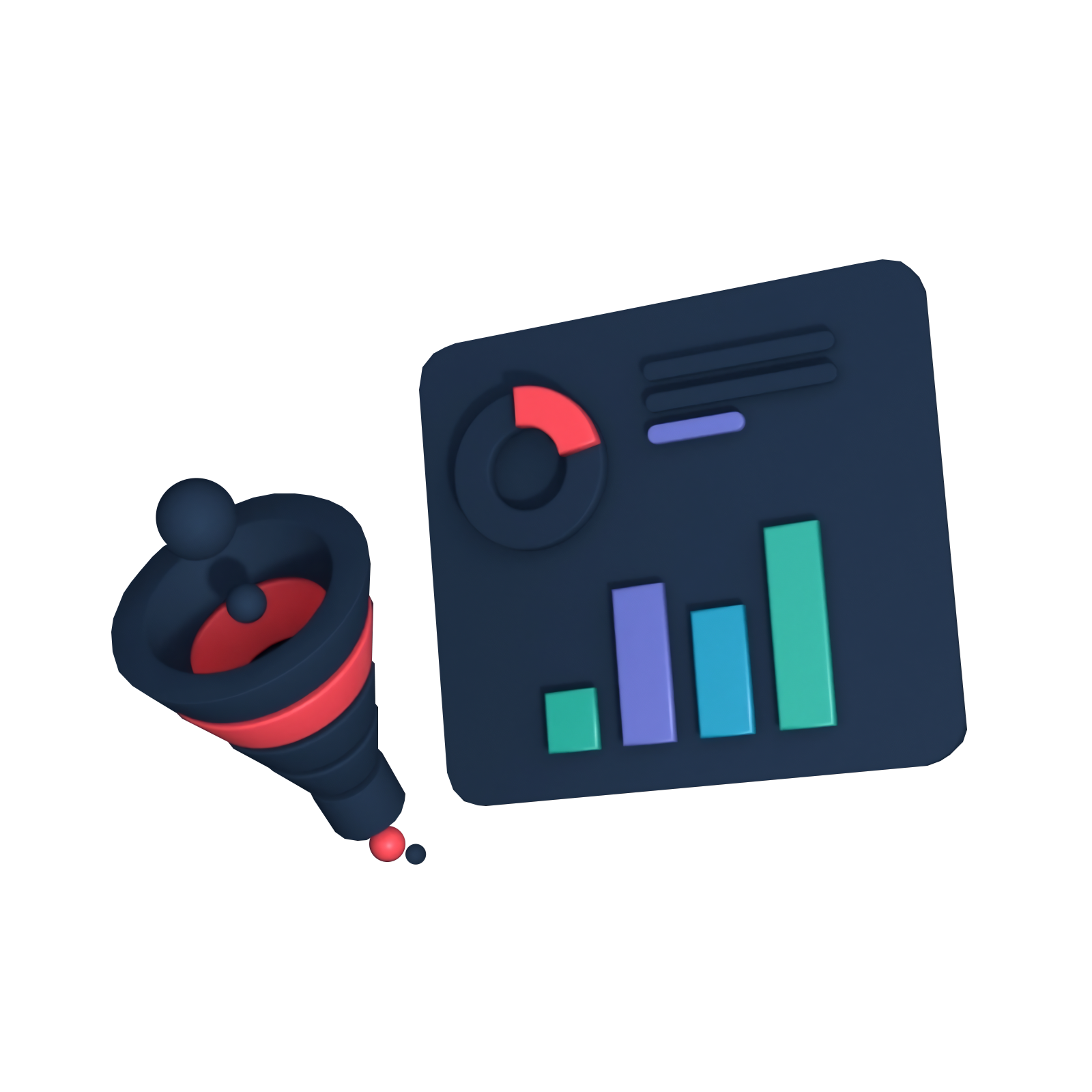



-3.png?width=500&height=320&name=Matt%20-%20imagery%20bank%20(8)-3.png)


